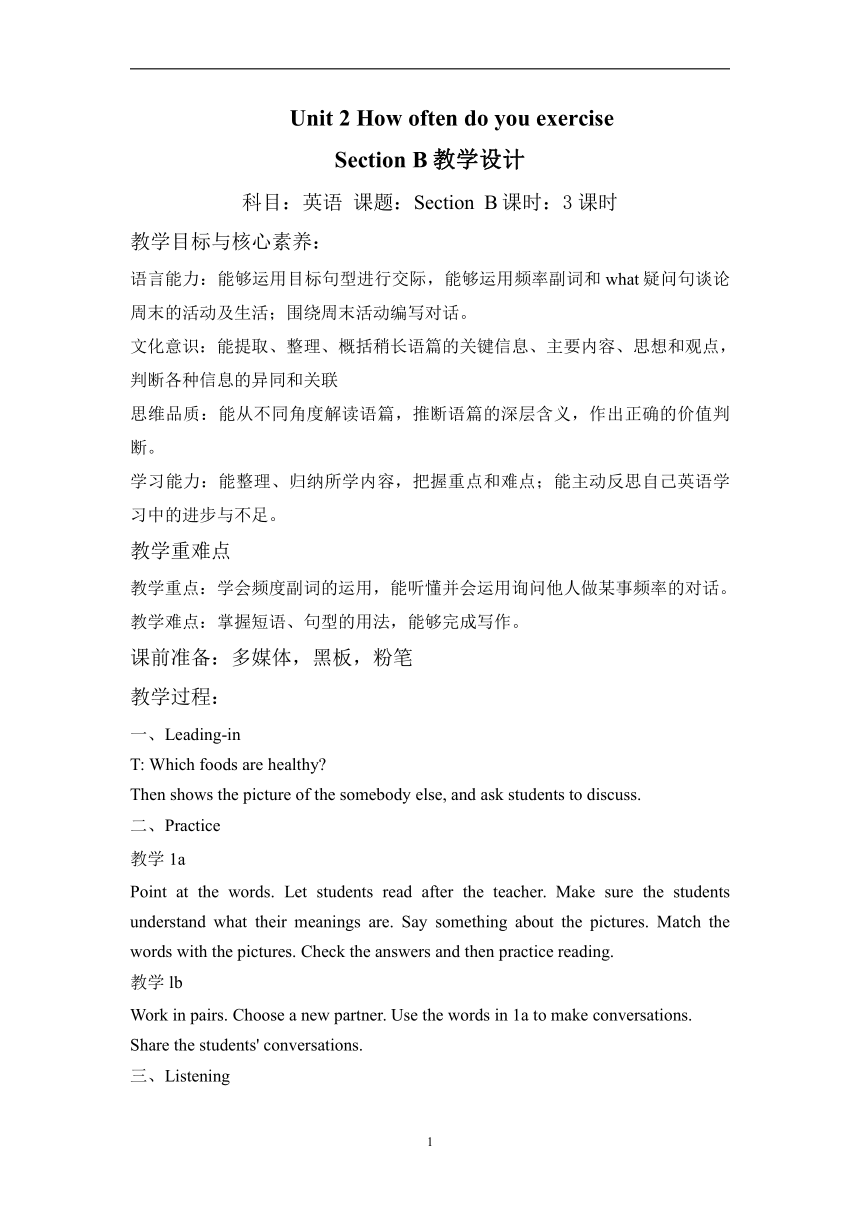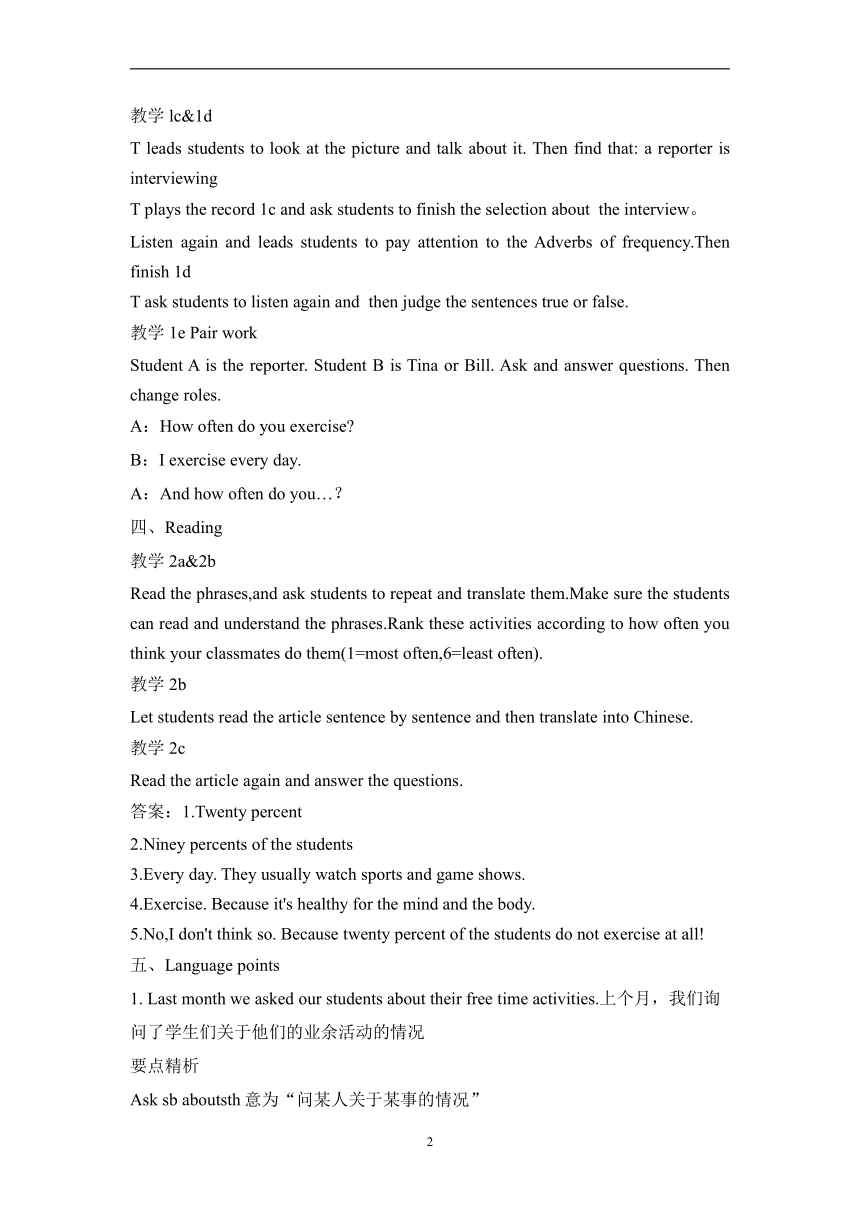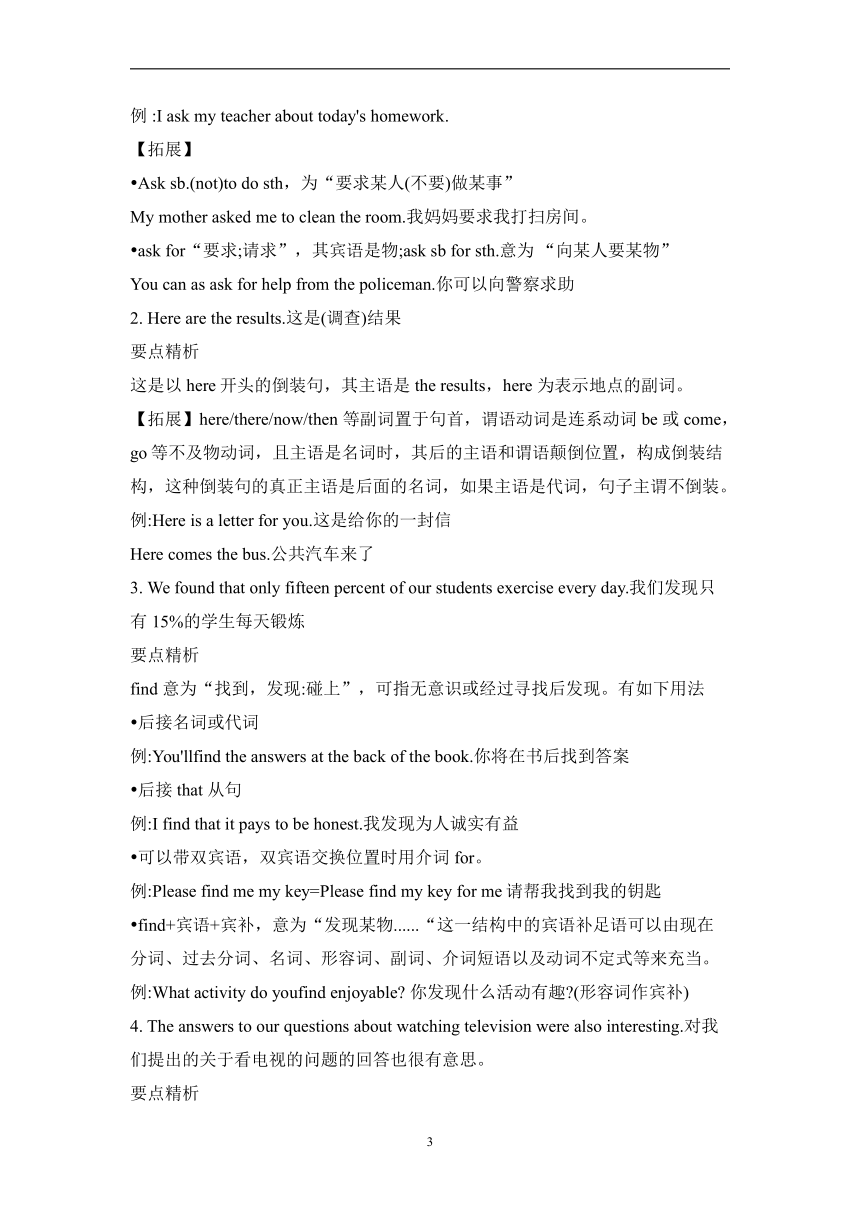Unit 2 How often do you exercise Section B 教案
文档属性
| 名称 | Unit 2 How often do you exercise Section B 教案 |

|
|
| 格式 | docx | ||
| 文件大小 | 29.7KB | ||
| 资源类型 | 教案 | ||
| 版本资源 | 人教新目标(Go for it)版 | ||
| 科目 | 英语 | ||
| 更新时间 | 2023-10-27 22:40:20 | ||
图片预览



文档简介
Unit 2 How often do you exercise
Section B教学设计
科目:英语 课题:Section B课时:3课时
教学目标与核心素养:
语言能力:能够运用目标句型进行交际,能够运用频率副词和what疑问句谈论周末的活动及生活;围绕周末活动编写对话。
文化意识:能提取、整理、概括稍长语篇的关键信息、主要内容、思想和观点,判断各种信息的异同和关联
思维品质:能从不同角度解读语篇,推断语篇的深层含义,作出正确的价值判断。
学习能力:能整理、归纳所学内容,把握重点和难点;能主动反思自己英语学习中的进步与不足。
教学重难点
教学重点:学会频度副词的运用,能听懂并会运用询问他人做某事频率的对话。
教学难点:掌握短语、句型的用法,能够完成写作。
课前准备:多媒体,黑板,粉笔
教学过程:
Leading-in
T: Which foods are healthy
Then shows the picture of the somebody else, and ask students to discuss.
二、Practice
教学1a
Point at the words. Let students read after the teacher. Make sure the students understand what their meanings are. Say something about the pictures. Match the words with the pictures. Check the answers and then practice reading.
教学lb
Work in pairs. Choose a new partner. Use the words in 1a to make conversations.
Share the students' conversations.
三、Listening
教学lc&1d
T leads students to look at the picture and talk about it. Then find that: a reporter is interviewing
T plays the record 1c and ask students to finish the selection about the interview。
Listen again and leads students to pay attention to the Adverbs of frequency.Then finish 1d
T ask students to listen again and then judge the sentences true or false.
教学1e Pair work
Student A is the reporter. Student B is Tina or Bill. Ask and answer questions. Then change roles.
A:How often do you exercise
B:I exercise every day.
A:And how often do you…?
四、Reading
教学2a&2b
Read the phrases,and ask students to repeat and translate them.Make sure the students can read and understand the phrases.Rank these activities according to how often you think your classmates do them(1=most often,6=least often).
教学2b
Let students read the article sentence by sentence and then translate into Chinese.
教学2c
Read the article again and answer the questions.
答案:1.Twenty percent
2.Niney percents of the students
3.Every day. They usually watch sports and game shows.
4.Exercise. Because it's healthy for the mind and the body.
5.No,I don't think so. Because twenty percent of the students do not exercise at all!
五、Language points
1. Last month we asked our students about their free time activities.上个月,我们询问了学生们关于他们的业余活动的情况
要点精析
Ask sb aboutsth意为“问某人关于某事的情况”
例 :I ask my teacher about today's homework.
【拓展】
Ask sb.(not)to do sth,为“要求某人(不要)做某事”
My mother asked me to clean the room.我妈妈要求我打扫房间。
ask for“要求;请求”,其宾语是物;ask sb for sth.意为 “向某人要某物”
You can as ask for help from the policeman.你可以向警察求助
2. Here are the results.这是(调查)结果
要点精析
这是以here开头的倒装句,其主语是 the results,here 为表示地点的副词。
【拓展】here/there/now/then 等副词置于句首,谓语动词是连系动词 be 或come,go等不及物动词,且主语是名词时,其后的主语和谓语颠倒位置,构成倒装结构,这种倒装句的真正主语是后面的名词,如果主语是代词,句子主谓不倒装。
例:Here is a letter for you.这是给你的一封信
Here comes the bus.公共汽车来了
3. We found that only fifteen percent of our students exercise every day.我们发现只有 15%的学生每天锻炼
要点精析
find 意为“找到,发现:碰上”,可指无意识或经过寻找后发现。有如下用法
后接名词或代词
例:You'llfind the answers at the back of the book.你将在书后找到答案
后接that 从句
例:I find that it pays to be honest.我发现为人诚实有益
可以带双宾语,双宾语交换位置时用介词 for。
例:Please find me my key=Please find my key for me请帮我找到我的钥匙
find+宾语+宾补,意为“发现某物......“这一结构中的宾语补足语可以由现在分词、过去分词、名词、形容词、副词、介词短语以及动词不定式等来充当。
例:What activity do youfind enjoyable 你发现什么活动有趣 (形容词作宾补)
4. The answers to our questions about watching television were also interesting.对我们提出的关于看电视的问题的回答也很有意思。
要点精析
the answers to...questions 为固定搭配,意为“......问题的答案/回答”
to在此为介词,意为“指向;对于;针对”
类似的短语还有: the key to the door门的钥匙;
The solution to the problem这个问题的解决办法
例:Can you find out the answers to the questions 你能找出这些问题的答案吗
5. It is good to relax by using the Internet or watching game shows,but we think the best way to relax is through exercise. 通过上网或看游戏类节目来放松很好,但是我们认为最好的放松方式是通过锻炼。
要点精析
句型"It+be+adi+to do...”中it为形式主语真正的主语是to do因为主语大长
为避免头重脚轻,要把它放在后面
【拓展】
It+be+adj.( +or sb.)+动词不定式+其他
这类句型常用形容词easy,difficult.,hard,important,possible 等作表语,有时
候为了强调动词不定式动作的执行者,常在动词不定式前加for sb.
例 : It's necessary for the young to master two foreign languages
年轻人掌握两门外语是有必要的。
It+be+adi.+ofsb.+动词不定式+其他
这类句型常用表示人的品质,性格特征的形容词,如:kind,nice,stupid, clever, foolish, polite ,impolite , silly , selfish, considerate 等
例 :It's very kind ofyou to help me with the work.=You are kind to help me with
The work你帮助我做这项工作真是太好了
六、Writing
【写作话题】
本单元的话题以谈论业余活动为主,主要谈论做事情的频率,同时本单元还涉及了体育锻炼、饮食的注意事项等,给出的建议也是写作的常考内容
【写作技巧】
(1)写这类文章时,最好开篇点题,让读者一目了然。合理使用频度副词、百分数等使文章更加有条理。在文章结尾,要表达自己的观点
(2)常用短语
do homework ;every day ;use the Internet ;at least; four times a week
(3)常用句型
Here are the results of…
... percent of the students...
The results about…
Old habits die hard.
(4)写作模板
开头——总述学生调查活动的结果
Here are the results of the student activity survey in Class 2, Grade 8
中间——分析三个方面的调查内容
...do homework...
...use the Internet...
...play sports…
结尾——表达观点
...Old habits die hard. We should…
七、Practice
教学3a
Tell students to look at the information in the chart and summarize the percentage for each activity.Then have students match the percentages with words.Have students read the report and try to fill in the blanks with the words summarized just now. Then check the answers in class.
教学3b
Let students complete the chart in 3b with their own information. Select some students to share their results in class.
教学3c
Let students write a report about their good and bad habits and say how often they do things,using the report in 3a as an example.
Self Check
1.Let students talk about the activities they do and don't do or their parents do and don't do and make a chart.
2.Let some students read their charts aloud. Then ask the students to try to write five sentences using the information above.
3.Make sure they use the correct form of the verbs.
八、Homework
1. 熟练掌握和运用单词。
2. 练习对话,记忆所学的语言结构
2
Section B教学设计
科目:英语 课题:Section B课时:3课时
教学目标与核心素养:
语言能力:能够运用目标句型进行交际,能够运用频率副词和what疑问句谈论周末的活动及生活;围绕周末活动编写对话。
文化意识:能提取、整理、概括稍长语篇的关键信息、主要内容、思想和观点,判断各种信息的异同和关联
思维品质:能从不同角度解读语篇,推断语篇的深层含义,作出正确的价值判断。
学习能力:能整理、归纳所学内容,把握重点和难点;能主动反思自己英语学习中的进步与不足。
教学重难点
教学重点:学会频度副词的运用,能听懂并会运用询问他人做某事频率的对话。
教学难点:掌握短语、句型的用法,能够完成写作。
课前准备:多媒体,黑板,粉笔
教学过程:
Leading-in
T: Which foods are healthy
Then shows the picture of the somebody else, and ask students to discuss.
二、Practice
教学1a
Point at the words. Let students read after the teacher. Make sure the students understand what their meanings are. Say something about the pictures. Match the words with the pictures. Check the answers and then practice reading.
教学lb
Work in pairs. Choose a new partner. Use the words in 1a to make conversations.
Share the students' conversations.
三、Listening
教学lc&1d
T leads students to look at the picture and talk about it. Then find that: a reporter is interviewing
T plays the record 1c and ask students to finish the selection about the interview。
Listen again and leads students to pay attention to the Adverbs of frequency.Then finish 1d
T ask students to listen again and then judge the sentences true or false.
教学1e Pair work
Student A is the reporter. Student B is Tina or Bill. Ask and answer questions. Then change roles.
A:How often do you exercise
B:I exercise every day.
A:And how often do you…?
四、Reading
教学2a&2b
Read the phrases,and ask students to repeat and translate them.Make sure the students can read and understand the phrases.Rank these activities according to how often you think your classmates do them(1=most often,6=least often).
教学2b
Let students read the article sentence by sentence and then translate into Chinese.
教学2c
Read the article again and answer the questions.
答案:1.Twenty percent
2.Niney percents of the students
3.Every day. They usually watch sports and game shows.
4.Exercise. Because it's healthy for the mind and the body.
5.No,I don't think so. Because twenty percent of the students do not exercise at all!
五、Language points
1. Last month we asked our students about their free time activities.上个月,我们询问了学生们关于他们的业余活动的情况
要点精析
Ask sb aboutsth意为“问某人关于某事的情况”
例 :I ask my teacher about today's homework.
【拓展】
Ask sb.(not)to do sth,为“要求某人(不要)做某事”
My mother asked me to clean the room.我妈妈要求我打扫房间。
ask for“要求;请求”,其宾语是物;ask sb for sth.意为 “向某人要某物”
You can as ask for help from the policeman.你可以向警察求助
2. Here are the results.这是(调查)结果
要点精析
这是以here开头的倒装句,其主语是 the results,here 为表示地点的副词。
【拓展】here/there/now/then 等副词置于句首,谓语动词是连系动词 be 或come,go等不及物动词,且主语是名词时,其后的主语和谓语颠倒位置,构成倒装结构,这种倒装句的真正主语是后面的名词,如果主语是代词,句子主谓不倒装。
例:Here is a letter for you.这是给你的一封信
Here comes the bus.公共汽车来了
3. We found that only fifteen percent of our students exercise every day.我们发现只有 15%的学生每天锻炼
要点精析
find 意为“找到,发现:碰上”,可指无意识或经过寻找后发现。有如下用法
后接名词或代词
例:You'llfind the answers at the back of the book.你将在书后找到答案
后接that 从句
例:I find that it pays to be honest.我发现为人诚实有益
可以带双宾语,双宾语交换位置时用介词 for。
例:Please find me my key=Please find my key for me请帮我找到我的钥匙
find+宾语+宾补,意为“发现某物......“这一结构中的宾语补足语可以由现在分词、过去分词、名词、形容词、副词、介词短语以及动词不定式等来充当。
例:What activity do youfind enjoyable 你发现什么活动有趣 (形容词作宾补)
4. The answers to our questions about watching television were also interesting.对我们提出的关于看电视的问题的回答也很有意思。
要点精析
the answers to...questions 为固定搭配,意为“......问题的答案/回答”
to在此为介词,意为“指向;对于;针对”
类似的短语还有: the key to the door门的钥匙;
The solution to the problem这个问题的解决办法
例:Can you find out the answers to the questions 你能找出这些问题的答案吗
5. It is good to relax by using the Internet or watching game shows,but we think the best way to relax is through exercise. 通过上网或看游戏类节目来放松很好,但是我们认为最好的放松方式是通过锻炼。
要点精析
句型"It+be+adi+to do...”中it为形式主语真正的主语是to do因为主语大长
为避免头重脚轻,要把它放在后面
【拓展】
It+be+adj.( +or sb.)+动词不定式+其他
这类句型常用形容词easy,difficult.,hard,important,possible 等作表语,有时
候为了强调动词不定式动作的执行者,常在动词不定式前加for sb.
例 : It's necessary for the young to master two foreign languages
年轻人掌握两门外语是有必要的。
It+be+adi.+ofsb.+动词不定式+其他
这类句型常用表示人的品质,性格特征的形容词,如:kind,nice,stupid, clever, foolish, polite ,impolite , silly , selfish, considerate 等
例 :It's very kind ofyou to help me with the work.=You are kind to help me with
The work你帮助我做这项工作真是太好了
六、Writing
【写作话题】
本单元的话题以谈论业余活动为主,主要谈论做事情的频率,同时本单元还涉及了体育锻炼、饮食的注意事项等,给出的建议也是写作的常考内容
【写作技巧】
(1)写这类文章时,最好开篇点题,让读者一目了然。合理使用频度副词、百分数等使文章更加有条理。在文章结尾,要表达自己的观点
(2)常用短语
do homework ;every day ;use the Internet ;at least; four times a week
(3)常用句型
Here are the results of…
... percent of the students...
The results about…
Old habits die hard.
(4)写作模板
开头——总述学生调查活动的结果
Here are the results of the student activity survey in Class 2, Grade 8
中间——分析三个方面的调查内容
...do homework...
...use the Internet...
...play sports…
结尾——表达观点
...Old habits die hard. We should…
七、Practice
教学3a
Tell students to look at the information in the chart and summarize the percentage for each activity.Then have students match the percentages with words.Have students read the report and try to fill in the blanks with the words summarized just now. Then check the answers in class.
教学3b
Let students complete the chart in 3b with their own information. Select some students to share their results in class.
教学3c
Let students write a report about their good and bad habits and say how often they do things,using the report in 3a as an example.
Self Check
1.Let students talk about the activities they do and don't do or their parents do and don't do and make a chart.
2.Let some students read their charts aloud. Then ask the students to try to write five sentences using the information above.
3.Make sure they use the correct form of the verbs.
八、Homework
1. 熟练掌握和运用单词。
2. 练习对话,记忆所学的语言结构
2
同课章节目录
- Unit 1 Where did you go on vacation?
- Section A
- Section B
- Unit 2 How often do you exercise?
- Section A
- Section B
- Unit 3 I'm more outgoing than my sister.
- Section A
- Section B
- Unit 4 What's the best movie theater?
- Section A
- Section B
- Unit 5 Do you want to watch a game show?
- Section A
- Section B
- Unit 6 I'm going to study computer science.
- Section A
- Section B
- Unit 7 Will people have robots?
- Section A
- Section B
- Unit 8 How do you make a banana milk shake?
- Section A
- Section B
- Unit 9 Can you come to my party?
- Section A
- Section B
- Unit 10 If you go to the party, you'll have a grea
- Section A
- Section B
